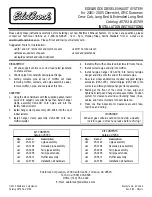
167
3. Clean the tank of master cylinder from dust and dirt around the
cap and uncover it. Fill the tank with brake fluid up to MAX mark.
4. Press the brake pedal several times to eliminate effect of the
vacuum formation in the brake booster.
5. Bleed successively the chambers of the right and left rear
brakes wheel cylinders, the front circuit of the proportioning
valve (for non-ABS motor vehicles), and then the right and left
crankcases of front brakes.
Bleed the system as follows:
WARNING!
While bleeding, add the fluid to the master cylinder
tank in time and do not let the fluid level decrease lower than 2/3
of the tank volume. Do not let air come into the system.
If air comes into the brake system of the ABS-equipped motor
vehicle, contact a service station. It is forbidden to operate a motor
vehicle until the malfunction is eliminated.
1. Remove the cap from the bypass valve of the wheel cylinder,
from the crankcase or from the proportioning valve (for non-ABS
motor vehicles) and put a special rubber hose (approx. 400 mm
long) on the valve.
Drop the other end of the hose into a transparent vessel, no less
than 0.5 L, which is half-filled with brake fluid.
2. Press the brake pedal 3–5 times abruptly, hold it in the
extreme position and simultaneously unscrew the bypass valve
for 1/2–3/4 of a turn to release the fluid portion from the system
to a vessel. After the pedal goes forward up to the stop, screw the
valve. Repeat the operation until bubbles stop coming out from
the hose dropped into the vessel with brake fluid.
3. Once bleeding is over, press the pedal and hold it in the
extreme position, screw the bypass valve (see Annex 2) and remove
the hose. Dry the valve head and put on the safety cap.
4. Add brake fluid up to MAX mark into the master cylin
-
der tank.
Cover the tank cap. Screw the cap tightly with effort, carefully
to avoid breaking it.
Summary of Contents for CARGO
Page 206: ...For Notes ...
Page 207: ...For Notes ...
















































